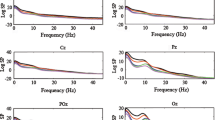Abstract
Spatiotemporal characteristics of spontaneous alpha EEG activity patterns are analyzed in terms of large-scale phase synchronization. During periods with strong phase synchronization over the entire scalp, phase patterns take either of two forms; one is a gradual phase shift between frontal and occipital regions and the other is a stepwise pattern with a sudden phase shift in the central region. The former is regarded as a traveling wave of electrocortical activity, of which the direction of propagation is predominantly from anterior to posterior in three out of four subjects, and opposite in the remaining one. The other activity pattern observed may correspond to a standing wave composed of two traveling waves propagating in opposite directions. The duration distributions of these patterns have similar forms within a subject, which suggests that they share the same mechanism for their generation.
Similar content being viewed by others
References
Bhattacharya J, Petsche H, Feldmann U, Rescher B (2001) EEG gamma-band phase synchronization between posterior and frontal cortex during mental rotation in humans. Neurosci Lett 311:29–31
Burkitt GR, Silberstein RB, Cadusch PJ, Wood AW (2000) Steady-state visual evoked potentials and travelling waves. Clin Neurophys 111:246–258
Fell J, Klaver P, Lehnertz K, Grunwald T, Schaller C, Elger CE, Fernández G (2001) Human memory formation is accompanied by rhinal-hippocampal coupling and decoupling. Nat Neurosci 4:1259–1264
Gong P, Nikolaev AR, van Leeuwen C (2003) Scale-invariant fluctuations of the dynamical synchronization in human brain electrical activity. Neurosci Lett 336:33–36
Inouye T, Shinosaki K, Toi S, Matsumoto Y, Hosaka N (1995) Potential flow of α activity in the human electroencephalogram. Neurosci Lett 187:29–32
Nunez PL (1974) Wavelike properties of the alpha rhythm. IEEE Trans Biomed Eng 21:473–482
Nunez PL, Wingeier BM, Silberstein RB (2001) Spatial- temporal structures of human alpha rhythms: theory, microcurrent sources, multiscale measurements, and global binding of local networks. Hum Brain Mapp 13:125–164
Ozaki H, Suzuki H (1987) Transverse relationships of the alpha-rhythm on the scalp. Electroencephalogr Clin Neurophysiol 66:191–195
Petsche H, Sterc J (1968) The significance of the cortex for the travelling phenomenon of brain waves. Electroencephalogr Clin Neurophysiol 25:11–22
Rodriguez E, George N, Lachaux JP, Martinerie J, Renault B, Varela FJ (1999) Perception’s shadow: long-distance synchronization of human brain activity. Nature 397:430–433
Rosenblum M, Pikovsky A, Schafer C, Tass PA, Kurths J (2000) Phase synchronization: from theory to data analysis. In: Moss F, Gielen S (eds) Neuro-informatics and neural modelling. Elsevier, Amsterdam, pp 279–321
Sarnthein J, Petsche H, Rappelsberger P, Shaw GL, von Stein A (1998) Synchronization between prefrontal and posterior association cortex during human working memory. Proc Natl Acad Sci USA 95:7092–7096
Schack B, Weiss S, Rappelsberger P (2003) Cerebral information transfer during word processing: where and when does it occur and how fast is it? Hum Brain Mapp 19:18–36
Shaw JC, McLachlan KR (1968) The association between alpha rhythm propagation time and level of arousal. Psychophysiology 4:307–310
Silberstein RB, Danieli F, Nunez PL (2003) Fronto-parietal evoked potential synchronization is increased during mental rotation. Neuroreport 14:67–71
Thatcher RW, Krause P, Hrybyk M (1986) Corticocortical associations and EEG coherence – a 2-compartmental model. Electroencephalogr Clin Neurophysiol 64:123–143
Author information
Authors and Affiliations
Corresponding author
Rights and permissions
About this article
Cite this article
Ito, J., Nikolaev, A. & Leeuwen, C. Spatial and temporal structure of phase synchronization of spontaneous alpha EEG activity. Biol Cybern 92, 54–60 (2005). https://doi.org/10.1007/s00422-004-0533-z
Received:
Accepted:
Published:
Issue Date:
DOI: https://doi.org/10.1007/s00422-004-0533-z




